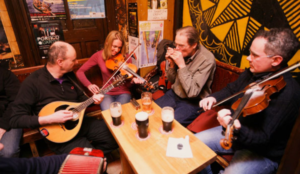 Also called Irish folk music, or Irish trad, this is the genre of folk music that developed in Ireland. As we’ve already seen, Ireland is a country rich with musical culture, and what kind of blog would this be, indeed, if I didn’t explore the traditional music. It all started in Gaelic Ireland, that is, Ireland from the prehistoric era to the 17th century. According to W. H. Grattan Flood, there were at the very least ten instruments being used in Gaelic Ireland. To make things a little easier for everyone (like when you just pitch in for a limousine service to get you to prom so you don’t all have to take separate vehicles), I’ll give you the modern English descriptions, and put the Irish names in brackets. So! First of all, there were two types of harp, one smaller (cruit) and another larger one that usually had around 30 strings (clairsearch).
Also called Irish folk music, or Irish trad, this is the genre of folk music that developed in Ireland. As we’ve already seen, Ireland is a country rich with musical culture, and what kind of blog would this be, indeed, if I didn’t explore the traditional music. It all started in Gaelic Ireland, that is, Ireland from the prehistoric era to the 17th century. According to W. H. Grattan Flood, there were at the very least ten instruments being used in Gaelic Ireland. To make things a little easier for everyone (like when you just pitch in for a limousine service to get you to prom so you don’t all have to take separate vehicles), I’ll give you the modern English descriptions, and put the Irish names in brackets. So! First of all, there were two types of harp, one smaller (cruit) and another larger one that usually had around 30 strings (clairsearch).
Next, we’ve got another little stringed instrument (timpan), a fife (feadan), and an oboe or flute (buinne). As for the horn section, there was a horn that worked kind of like a bassoon (guthbuinne), two hornpipes (bennbuabhal and corn), and some clarions or trumpets (stoc and sturgan). An instrument that I admittedly wasn’t expecting to see in the list were castanets (cnamha), yet there they were! And then, something that I’m sure we were all expecting, the bagpipes (cuislenna), which are, let’s take a moment to recognize, are different than Scottish bagpipes. But that’s another post. Finally, there is also evidence of the fiddle being used as early as the 8th century, which also surprised me, though I don’t know if it should have.
Anyway, so now we’ve got the players, so what were they playing? Well, taking a step back first, actually, let’s look at the music that was written primarily (and sometimes exclusively) for the voice. Music that is sung without instrument, that is, a cappella, is called sean nós, which means, “in the old style.” Most often, this music is sung alone, and is extremely ornamented. It’s considered the apex of traditional singing, and the most talented singers will provide their own interpretation of the melody, varying it slightly, but never at the expense of the words.
Perhaps some of the most well-known type of Irish music is that used for dancing. As far as we know, that was the main purpose of Irish traditional music, that is, to be danced to! Which is such a fun thing. And there are lots of different kinds of dances, too! The Irish take their dancing very seriously. There’s the reel and the hornpipe, both in 4/4 time, and then the jig, in 6/8, and let’s not forget the waltzes and highlands and polkas and the list goes on!
Because the melody is so important in Irish traditional music, the harmonies used are relatively simple, and all the instruments generally played in unison. And speaking of instruments! The instruments most commonly used in Irish folk dance music are the fiddle, as you may expect, as well as the tin whistle and the flute, and also the Uilleann pipes. For more about the Uilleann pipes, see an upcoming post. Until then, may I recommend you geta hold of some Irish folk and have a listen!